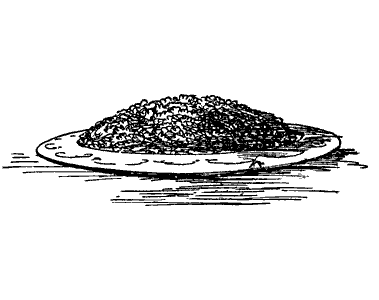Let's do things backwards today. Before I get into the details of buckwheat, how about a recipe?
Spiced Buckwheat Pancakes
(for 2 or 3 people)
1 cup buckwheat pancake mix (I use Bob's Red Mill Buckwheat Pancake Mix)
1 organic egg, beaten
2 tablespoons vegetable oil (canola is a good choice)
1/4 tsp ground ginger
1/2 tsp ground cinnamon
1 tablespoon organic cane sugar
filtered water
real unsalted organic butter (no margarine or butter substitutes)
Combine all ingredients in a medium mixing bowl except for the water and the butter. The mixture will probably get very thick and gummy. Add about 1/2 cup of water to get the batter evenly moist and mixed. Add more water 1/4 cup at a time until the batter is of the consistency you prefer. I like my pancake batter liquid, but not watery. These pancakes tend to puff up a bit so you may want your batter slightly runnier than traditional pancake batter. If in doubt, try making a pancake with your batter thicker and see if you like.
Warm a large skillet on medium heat. Add a little bit of butter, let it melt and swirl it around the pan. Pour a small amount of batter into the pan so that the final size of the pancake is about 3 or 4 inches across. (Small pancakes like these cook faster and are easier to handle without ruining them. If you feel confident you can tackle bigger pancakes, go for it.) Let the pancake cook until the edges start to solidify. The batter will bubble a bit and when the bubbles have gotten bigger and deeper, you should start thinking about flipping them. They need a minute or so on the other side.
Serve the hot pancakes immediately. They can be served with regular syrup, but as syrup is typically made of high fructose corn syrup you may want to try some other options. In our house we prefer real maple syrup, used sparingly. The traditional way to eat buckwheat pancakes is with applesauce. You can also try a bit of molasses with them for a rich, vitamin-packed treat.
So while you are munching away on your easy, delicious pancakes, let's talk about buckwheat and why it is good for you.
Buckwheat, also know as Fagopyrum esculentum, is native to parts of Eurasia and was first cultivated about 6000 BC in Southeast Asia. It was subsequently grown all over Asia, Europe and Africa. It was also one of the first crops cultivated by Europeans in North America. These days buckwheat is grown all over the world.
Buckwheat is not wheat (although sometimes it is mixed with wheat flour so be careful if you have a wheat allergy). In fact buckwheat isn't even a grain. It's the seed of a grass-like plant related to rhubarb. Buckwheat's name comes from the fact that it resembles beech nuts and is used in a fashion similar to the way wheat is used.
This tasty little seed has been used in cooking all over the world and has played a major role in the cuisine of many countries. Japan's famous soba noodles are made of buckwheat as is kasha from Russia. Breton gallettes feature buckwheat flour crepes. Northern Italians enjoy polenta made with buckwheat.
Since buckwheat is not a grain, it contains no gluten, making it a good choice for folks with wheat allergies. You can even find beer made with buckwheat malt that contains no wheat. (Look for gluten free beer.)
Buckwheat is high in magnesium, which contributes to healthy muscles. Buckwheat proteins contain eight essential amino acids. It is high in lysine. Buckwheat is also a good source of Alpha-Linolenic Acid, which is one of the two essential fatty acids necessary for human health. Buckwheat is a great source of fiber, which can lower 'bad' cholesterol levels. Another great property of buckwheat is that it contains rutin, which is a compound that helps strengthen the walls of capillaries, thus reducing the likelihood and occurrence of hemorrhaging in people with high blood pressure.
As if all that wasn't good enough, buckwheat grows best in poor soil. In fact if soil is fertilized, it may reduce crop yields. Buckwheat is drought resistant, pest resistant and it doesn't require a long growing season. Most buckwheat is grown without any fertilizers or pesticides. Much of what is available for purchase is organic, although it is rarely certified as such. Simply put, this is a crop that is ideal for a small planet.
You can find whole buckwheat groats (the whole interior seed, hull removed) or buckwheat flour at most health food stores. If you live someplace with easy access to Whole Foods or a food coop you can also find it there. You may also find buckwheat at Russian/Eastern European food specialty shops. Soba noodles can be found at many grocery stores, and definitely at Japanese and Korean groceries.
Buckwheat is all-around good for you and for the planet. There's no good reason not to be eating it. There are lots of ways to enjoy buckwheat. At some point I'll revisit buckwheat and get you some more recipes. In the mean time, if you are hungering for more ways to cook buckwheat, try looking for kasha, or soba noodle recipes.

This comment has been removed by a blog administrator.
ReplyDelete